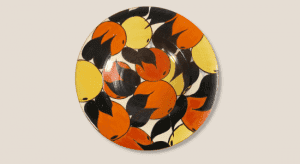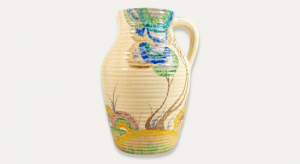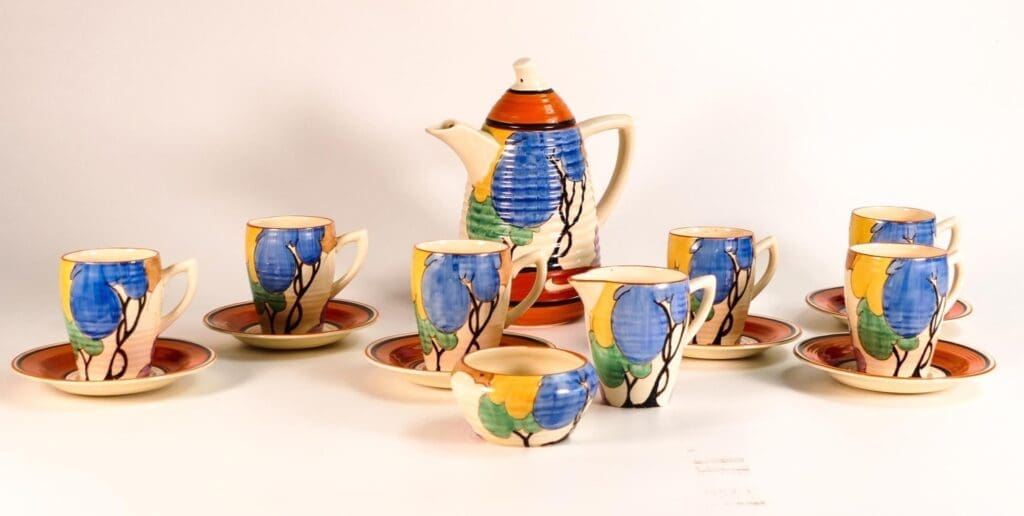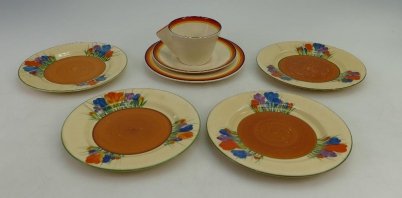Clarice Cliff was one of the world’s most influential ceramics artists, and her works regularly feature in our auctions. Clarice Cliff’s Art Deco ceramic designs are highly distinctive in style, which led to her becoming a leading brand at the Burslem pottery Wilkinson’s, at which she worked. A contemporary of Charlotte Rhead and Susie Cooper, her brightly coloured Art Deco designs were much admired in the 1930s when she first produced them. Clarice Cliff pottery enjoyed a renaissance in the 1970s and is still a popular, collectable name to this day.
Potteries Auctions can identify and provide valuations on a wide range of Clarice Cliff ceramics at auction.
Popular Clarice Cliff Ceramics at Auction

Clarice Cliff Bizarre Fantasque Newport Pottery hand painted shallow bowl
£3,800

Clarice Cliff Wilkinsons Lotus Jug in blue Rhodanthe
£350

Clarice Cliff three-piece teaset in the Solomons Seal design
£470
Clarice Cliff for Newport Pottery, Fantasque Bizarre Red Trees & House Pattern tea set
£800

Rare Clarice Cliff Blue Autumn coffee set in Lynton shape c1934
£1,400
Got an interesting item?
Speak to one of our experts to find out the value of your pottery, antiques, jewellery, & collectables
Book a valuationWhether you are looking to buy or sell Clarice Cliff ceramics or collectables, the team of experts at Potteries Auctions can help you find the piece you are looking for, or value your items for sale. Request a call back if you are looking for a valuation and are seeking to sell some Clarice Cliff collector pieces at auction.
Pottery Painter Clarice Cliff Facts
- Clarice began her career at the tender age of 13 as an apprentice enameller, before she joined Wilkinson’s pottery in Burslem.
- One of the most influential names in British Design during the Art Deco period, her work is perhaps the most distinctive of all her contemporaries at the time, and are still very much highly sought after.
- The most-sought after designs are pre-1935 in era and include Bizarre and Fantasque.

The History of Clarice Cliff Art Deco Ceramics
Clarice Cliff was born in January 1899 in Tunstall, Staffordshire and died in Newcastle-under-Lyme in October 1972. The fourth of eight children of an iron-moulder, Clarice Cliff started working at the age of 13 as an apprentice enameller.
At 17, she joined A. J. Wilkinson’s Royal Staffordshire Pottery as a lithographer, where her drawing ability was soon noticed. She attended evening classes at Burslem School of Art from 1924-1925, and studied sculpture at the Royal College of Art in 1927, but returned after only a few months to set up a small studio in Wilkinson’s Newport Pottery, decorating traditional white ware.
In 1927-8, a market testing of 60 dozen pieces of “Bizarre Ware” was organised by Colley Shorter. Wilkinson’s salesmen were shocked by the extreme boldness of Cliff’s designs, and further astonished by the rapidity with which they sold. Handpainted Bizarre, the name chosen by Colley Shorter, the managing director of Wilkinson’s to cover the whole range, was launched. In 1930, she was made Art Director of the firm and, in 1940, following the death of his first wife, she married Colley Shorter.
The enthusiasm which greeted Bizarre generated a burst of creative activity. By 1931, Cliff was supervising a workforce of up to 1000 at the Newport Pottery, with 150 boys and girls trained in the decorating shop, producing new modern shapes and designs.
Between 1932 and 1934, Clarice Cliff became involved in an historic, but short lived, attempt to combine the forces of the Pottery and Glass Industries and contemporary artists. Thomas Acland Fennemore, Art Director of E. Brain & Company, Foley China, together with the artist Graham Sutherland and the designer Milner Gray, invited leading artists of the day (themselves included) to contribute designs to be made in bone china by Foley, and in earthenware by Wilkinson’s.
Cliff had misgivings and insisted the list be extended to include other artists with a more popular appeal, such as Laura Knight and Frank Brangwyn. Although most of the artists concerned merely decorated blanks with which they were supplied, Laura Knight was able to design her own shapes, known as Circus. The completed designs toured the country, having been shown first at the Harrods Exhibition of 1934.

During the 1930’s, and to reflect changing tastes, the patterns and shapes produced by Wilkinson’s were to vary greatly, and in 1935-6 the Bizarre umbrella name was dropped; pieces then being marked Clarice Cliff. With the outbreak of war in 1939, creative output of the factory ceased, with much of the workforce being drafted into the Armed Forces.
Wartime restrictions on decorated pottery continued into the 1950’s, and the factory never produced pottery in the style or quantity of the pre-war period. Much of the design work was passed into other hands, with Clarice and Colley spending less time at the factory and more time travelling and promoting the wares of A. J. Wilkinson.
In 1961, Colley fell ill and died in 1963. Clarice Cliff decided the time had come to retire, and the factory sites were sold in August 1964 to Midwinter’s, thus ceasing the production of all original Clarice Cliff wares. With the factory site sold, there was to be no successor to Clarice Cliff and the production of original Clarice Cliff ended.
In 1971, Clarice Cliff was acknowledged as a major Art Deco designer by the Minneapolis Institute of Arts, when a large number of her pieces were included in their influential World of Art Deco Exhibition. With interest rising in her pre-war work, Cliff was persuaded to write her own memoirs. Sadly, age had started to affect her memory and some of the information Miss Cliff wrote is, we now know, inaccurate.
Get In Touch
Potteries Auctions can collect items for auction from anywhere in the UK, and we can also handle large collections from all over the world, so just get in touch with us to discuss. We pride ourselves in our packing and shipping service to get goods out to purchasers, making it a perfect solution for buyers who can’t attend auctions in person.
Sign up for our newsletter
If you would like to receive advance notification of upcoming auctions and sale notifications, then please subscribe to either our text alerts or email newsletter via the buttons below.
